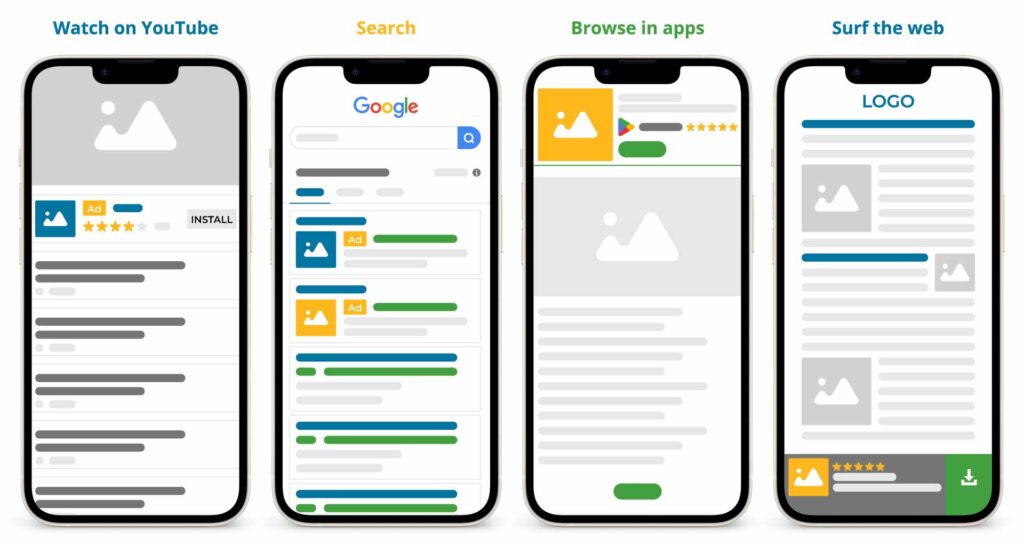In the world of performance marketing, choosing the right advertising platform is crucial for driving results. Google Ads and Meta Ads (formerly known as Facebook Ads) are two of the most powerful and popular digital advertising channels. While both platforms have their advantages, the question of which one is better depends on a variety of factors like business goals, audience, budget, and industry. This blog will explore the strengths of each platform to help you determine which is best suited for your needs.
1. Audience Reach and Targeting Capabilities
– Google Ads: Google Ads operates on the largest search engine in the world, allowing you to reach users when they are actively searching for specific information, products, or services. It uses keywords to target search intent, making it highly effective for capturing leads that are closer to making a purchase decision.
– Best for: Reaching users with high purchase intent, targeting specific keywords, and driving traffic through search results.
– Meta Ads: Meta Ads leverage Facebook and Instagram’s vast social media user base, offering powerful demographic, behavioral, and interest-based targeting. With Meta Ads, you can engage users based on their social behavior, interests, and interactions, making it an excellent platform for brand awareness and audience discovery.
– Best for: Broadening reach, building brand awareness, and engaging with users through dynamic, visual content.

2. Ad Formats and Creativity
Google Ads: Google Ads provide multiple formats such as search ads, display ads, shopping ads, and video ads (on YouTube). While search ads are text-based, display and video ads offer visual storytelling opportunities.
Strength: Ideal for direct-response campaigns, especially for businesses looking to capture search-driven leads or conversions.
Meta Ads: Meta excels at offering visually engaging ad formats, including carousel ads, story ads, video ads, and dynamic product ads. The immersive nature of Instagram and Facebook allows for creative expression, interactive elements, and video-heavy content, making it easier for brands to connect emotionally with their audiences.
Strength: Perfect for creative storytelling, product showcases, and brand building through visual engagement.
3. Cost and Return on Investment (ROI)
– Google Ads: Google Ads can be expensive, especially for competitive keywords in high-demand industries. However, it often delivers high-intent leads that are further down the sales funnel, which can result in a higher ROI for certain businesses. The cost-per-click (CPC) varies based on keyword competition, location, and bidding strategy.
– ROI Potential: Higher for businesses in B2B, service-based, or niche industries with strong search intent.
– Meta Ads: Meta Ads tend to have lower CPCs compared to Google Ads, making them more cost-effective for broad audience targeting. Meta Ads are particularly advantageous for businesses looking to build brand awareness or generate interest in new products. However, converting cold audiences may take longer.
– ROI Potential: Higher for consumer brands, e-commerce, and businesses focused on building customer relationships and retargeting.

4. Campaign Objectives
Google Ads: Google Ads is designed to capture demand. It’s excellent for driving immediate conversions, website traffic, or lead generation from users actively searching for specific products or services.
Best for: Lead generation, direct sales, service inquiries, and e-commerce purchases.
Meta Ads: Meta Ads excel in creating demand. If you are launching a new product or want to grow brand awareness, Meta’s powerful targeting and creative ad formats can help you connect with new audiences. It’s also effective for driving engagement, nurturing potential customers, and retargeting users who have interacted with your brand.
Best for: Brand awareness, audience engagement, customer loyalty, and social proof.
5. Data, Tracking, and Reporting
– Google Ads: Google offers robust tracking and reporting tools through Google Analytics and Google Ads Manager. It allows advertisers to track metrics like conversions, bounce rates, and time on site, helping businesses refine their ad strategy based on in-depth data.
– Strength: Advanced analytics and conversion tracking, especially for search campaigns.
– Meta Ads: Meta’s data reporting has been impacted by recent changes like Apple’s iOS 14 update, which restricts certain types of data tracking. However, Meta still provides a comprehensive set of metrics through Facebook Ads Manager, allowing advertisers to track engagement, conversion events, and audience insights.
– Strength: Strong for tracking social interactions, audience demographics, and ad engagement, but limited by privacy policies.
Which is Better for Your Business?
– Choose Google Ads if:
– You are targeting high-intent customers searching for specific solutions.
– You need immediate conversions, such as direct sales or lead generation.
– You have a higher budget for competitive keywords and a longer sales cycle.

Ultimately, the better platform depends on your business goals, audience, and industry. Here’s a quick breakdown:
– Choose Meta Ads if:
– You are looking to build awareness, tell a brand story, or engage a wide audience.
– You want to leverage highly creative ad formats for brand engagement.
– Your focus is on generating demand, nurturing leads, and retargeting warm audiences.
TL;DR
Both Google Ads and Meta Ads offer distinct advantages. Google Ads are unparalleled for intent-driven advertising, while Meta Ads offer creative and broad-reaching campaigns. A hybrid approach, leveraging both platforms, often yields the best results for businesses seeking a mix of direct response and long-term brand growth.
Consider your audience, objectives, and budget to choose the right platform—or better yet, experiment with both to see which delivers the best return for your business.



